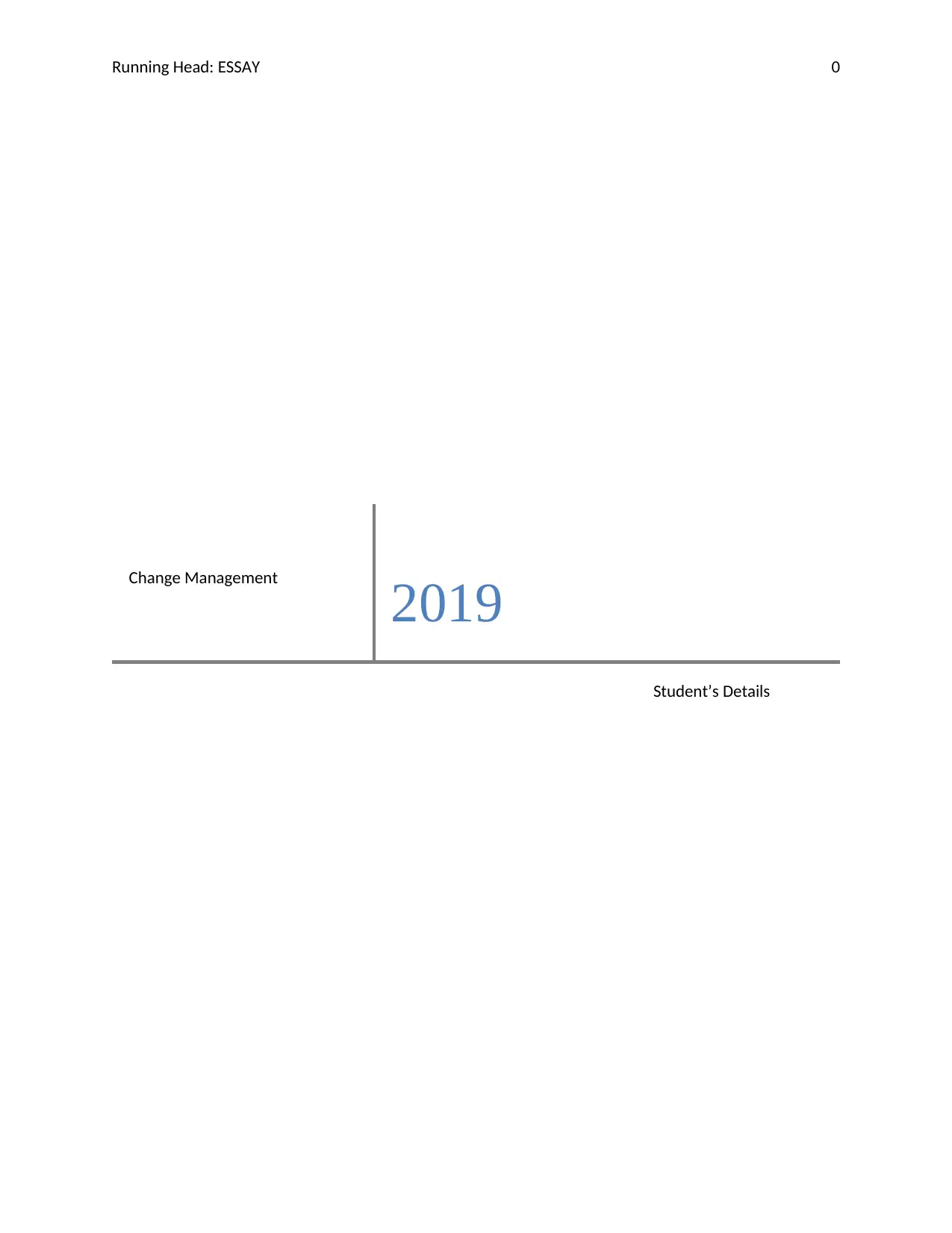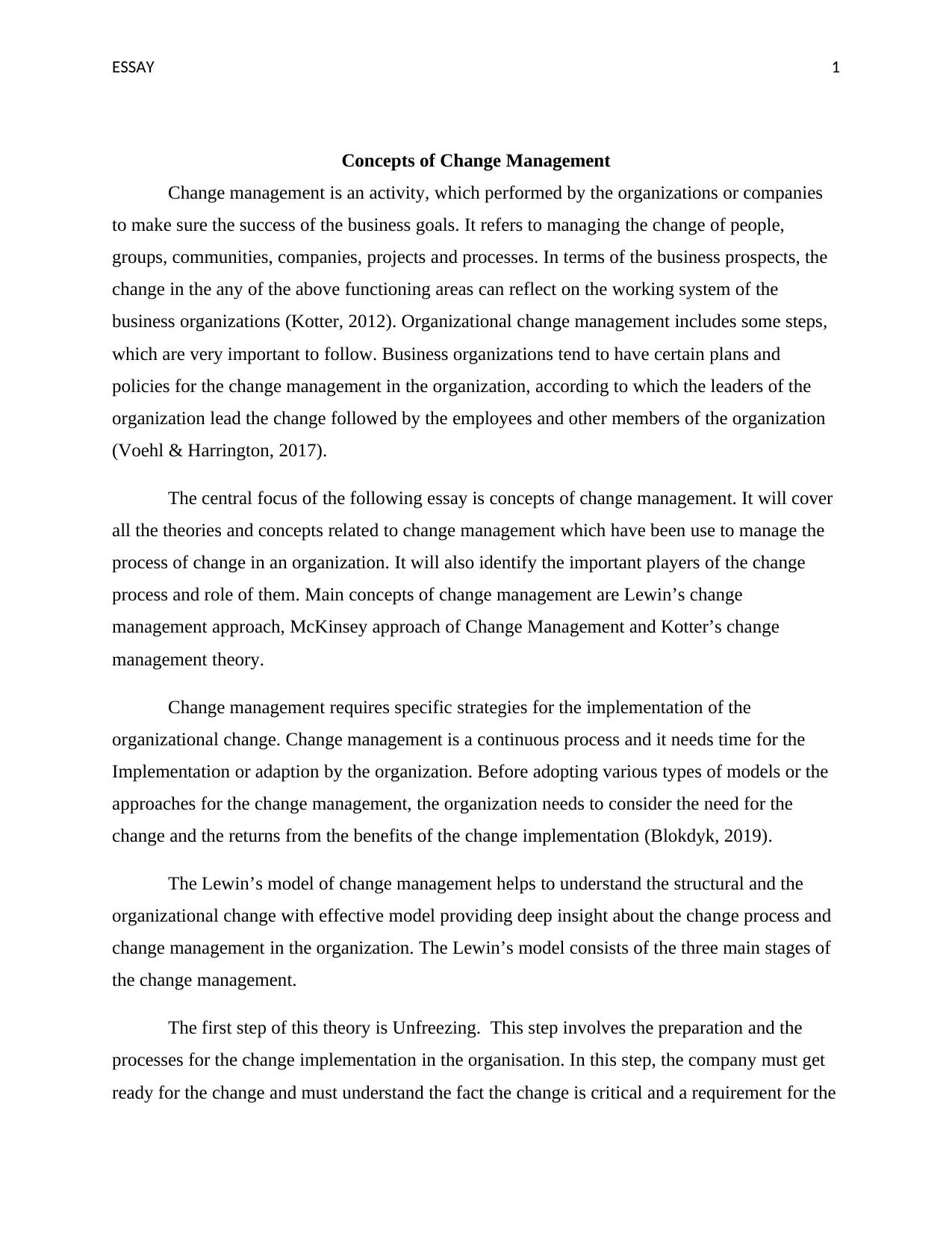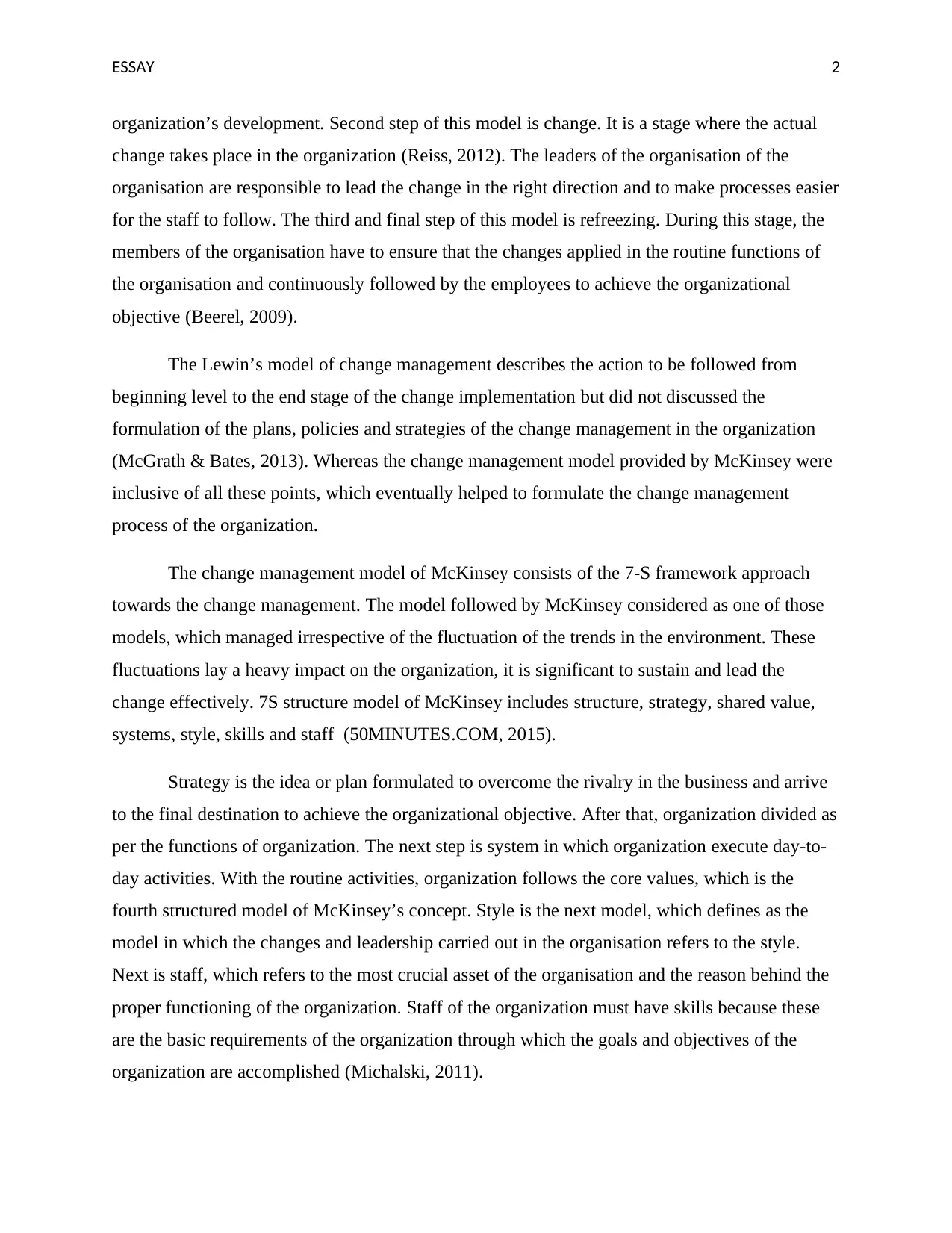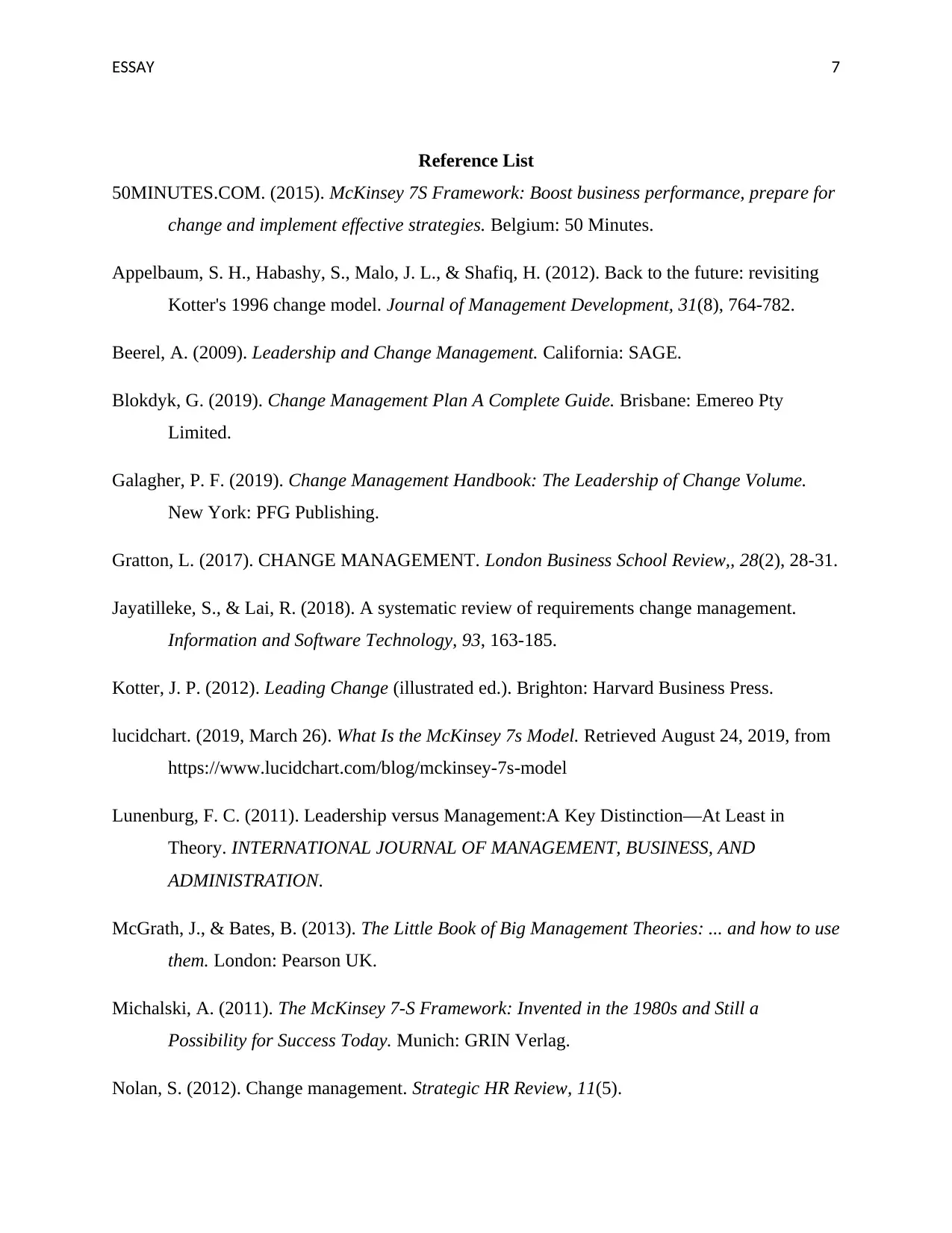Change Management: Theories, Key Roles, and a Consultant's Approach
VerifiedAdded on 2022/11/13
|9
|2671
|57
Essay
AI Summary
This essay provides a comprehensive overview of change management, exploring various theories and concepts. It begins by defining change management and its importance in achieving business goals. The essay then delves into three main approaches: Lewin’s change management model, McKinsey’s 7-S framework, and Kotter’s change management theory, highlighting their respective steps and considerations. It identifies the key players in the change process, including the organizational team, executives, managers, and project teams, detailing their roles and responsibilities in ensuring successful change implementation. Furthermore, it discusses the different types of change agents, both internal and external, emphasizing the importance of planning and strategy in managing change effectively. The essay concludes by presenting a change management plan, outlining the steps, objectives, activities, and expected outputs for each phase of the change process. The document is available on Desklib, a platform offering study tools and resources for students.

Running Head: ESSAY 0
Change Management
2019
Student’s Details
Change Management
2019
Student’s Details
Paraphrase This Document
Need a fresh take? Get an instant paraphrase of this document with our AI Paraphraser

ESSAY 1
Concepts of Change Management
Change management is an activity, which performed by the organizations or companies
to make sure the success of the business goals. It refers to managing the change of people,
groups, communities, companies, projects and processes. In terms of the business prospects, the
change in the any of the above functioning areas can reflect on the working system of the
business organizations (Kotter, 2012). Organizational change management includes some steps,
which are very important to follow. Business organizations tend to have certain plans and
policies for the change management in the organization, according to which the leaders of the
organization lead the change followed by the employees and other members of the organization
(Voehl & Harrington, 2017).
The central focus of the following essay is concepts of change management. It will cover
all the theories and concepts related to change management which have been use to manage the
process of change in an organization. It will also identify the important players of the change
process and role of them. Main concepts of change management are Lewin’s change
management approach, McKinsey approach of Change Management and Kotter’s change
management theory.
Change management requires specific strategies for the implementation of the
organizational change. Change management is a continuous process and it needs time for the
Implementation or adaption by the organization. Before adopting various types of models or the
approaches for the change management, the organization needs to consider the need for the
change and the returns from the benefits of the change implementation (Blokdyk, 2019).
The Lewin’s model of change management helps to understand the structural and the
organizational change with effective model providing deep insight about the change process and
change management in the organization. The Lewin’s model consists of the three main stages of
the change management.
The first step of this theory is Unfreezing. This step involves the preparation and the
processes for the change implementation in the organisation. In this step, the company must get
ready for the change and must understand the fact the change is critical and a requirement for the
Concepts of Change Management
Change management is an activity, which performed by the organizations or companies
to make sure the success of the business goals. It refers to managing the change of people,
groups, communities, companies, projects and processes. In terms of the business prospects, the
change in the any of the above functioning areas can reflect on the working system of the
business organizations (Kotter, 2012). Organizational change management includes some steps,
which are very important to follow. Business organizations tend to have certain plans and
policies for the change management in the organization, according to which the leaders of the
organization lead the change followed by the employees and other members of the organization
(Voehl & Harrington, 2017).
The central focus of the following essay is concepts of change management. It will cover
all the theories and concepts related to change management which have been use to manage the
process of change in an organization. It will also identify the important players of the change
process and role of them. Main concepts of change management are Lewin’s change
management approach, McKinsey approach of Change Management and Kotter’s change
management theory.
Change management requires specific strategies for the implementation of the
organizational change. Change management is a continuous process and it needs time for the
Implementation or adaption by the organization. Before adopting various types of models or the
approaches for the change management, the organization needs to consider the need for the
change and the returns from the benefits of the change implementation (Blokdyk, 2019).
The Lewin’s model of change management helps to understand the structural and the
organizational change with effective model providing deep insight about the change process and
change management in the organization. The Lewin’s model consists of the three main stages of
the change management.
The first step of this theory is Unfreezing. This step involves the preparation and the
processes for the change implementation in the organisation. In this step, the company must get
ready for the change and must understand the fact the change is critical and a requirement for the

ESSAY 2
organization’s development. Second step of this model is change. It is a stage where the actual
change takes place in the organization (Reiss, 2012). The leaders of the organisation of the
organisation are responsible to lead the change in the right direction and to make processes easier
for the staff to follow. The third and final step of this model is refreezing. During this stage, the
members of the organisation have to ensure that the changes applied in the routine functions of
the organisation and continuously followed by the employees to achieve the organizational
objective (Beerel, 2009).
The Lewin’s model of change management describes the action to be followed from
beginning level to the end stage of the change implementation but did not discussed the
formulation of the plans, policies and strategies of the change management in the organization
(McGrath & Bates, 2013). Whereas the change management model provided by McKinsey were
inclusive of all these points, which eventually helped to formulate the change management
process of the organization.
The change management model of McKinsey consists of the 7-S framework approach
towards the change management. The model followed by McKinsey considered as one of those
models, which managed irrespective of the fluctuation of the trends in the environment. These
fluctuations lay a heavy impact on the organization, it is significant to sustain and lead the
change effectively. 7S structure model of McKinsey includes structure, strategy, shared value,
systems, style, skills and staff (50MINUTES.COM, 2015).
Strategy is the idea or plan formulated to overcome the rivalry in the business and arrive
to the final destination to achieve the organizational objective. After that, organization divided as
per the functions of organization. The next step is system in which organization execute day-to-
day activities. With the routine activities, organization follows the core values, which is the
fourth structured model of McKinsey’s concept. Style is the next model, which defines as the
model in which the changes and leadership carried out in the organisation refers to the style.
Next is staff, which refers to the most crucial asset of the organisation and the reason behind the
proper functioning of the organization. Staff of the organization must have skills because these
are the basic requirements of the organization through which the goals and objectives of the
organization are accomplished (Michalski, 2011).
organization’s development. Second step of this model is change. It is a stage where the actual
change takes place in the organization (Reiss, 2012). The leaders of the organisation of the
organisation are responsible to lead the change in the right direction and to make processes easier
for the staff to follow. The third and final step of this model is refreezing. During this stage, the
members of the organisation have to ensure that the changes applied in the routine functions of
the organisation and continuously followed by the employees to achieve the organizational
objective (Beerel, 2009).
The Lewin’s model of change management describes the action to be followed from
beginning level to the end stage of the change implementation but did not discussed the
formulation of the plans, policies and strategies of the change management in the organization
(McGrath & Bates, 2013). Whereas the change management model provided by McKinsey were
inclusive of all these points, which eventually helped to formulate the change management
process of the organization.
The change management model of McKinsey consists of the 7-S framework approach
towards the change management. The model followed by McKinsey considered as one of those
models, which managed irrespective of the fluctuation of the trends in the environment. These
fluctuations lay a heavy impact on the organization, it is significant to sustain and lead the
change effectively. 7S structure model of McKinsey includes structure, strategy, shared value,
systems, style, skills and staff (50MINUTES.COM, 2015).
Strategy is the idea or plan formulated to overcome the rivalry in the business and arrive
to the final destination to achieve the organizational objective. After that, organization divided as
per the functions of organization. The next step is system in which organization execute day-to-
day activities. With the routine activities, organization follows the core values, which is the
fourth structured model of McKinsey’s concept. Style is the next model, which defines as the
model in which the changes and leadership carried out in the organisation refers to the style.
Next is staff, which refers to the most crucial asset of the organisation and the reason behind the
proper functioning of the organization. Staff of the organization must have skills because these
are the basic requirements of the organization through which the goals and objectives of the
organization are accomplished (Michalski, 2011).
⊘ This is a preview!⊘
Do you want full access?
Subscribe today to unlock all pages.

Trusted by 1+ million students worldwide

ESSAY 3
McKinsey’s concept has many advantages and disadvantages. The model includes the
deep insight in to the process of the change management and the factors that contribute the most
towards it. This concept signified both practical and emotional components of the change which
eventually helps the employees in the transformation process. However, this concept is complex
and due to the complexity, most of the organisations suffer at times because of the lack of
understanding of the implementation model (lucidchart, 2019).
Another concept of change management is Kotter’s change management theory. It is very
popular and the most approved theory by different organizations for change management. The
theory comprises of eight stages that focuses on the objective of the change management
(Appelbaum, Habashy, Malo, & Shafiq, 2012).
The first step of this concept is increase urgency, which involves the sense of insistence
for the organisational change to motivate them to achieving the objective of the company. The
next step involves the structuring of the team for the change management. Third step is vision to
connect, that refers to creating a vision by focusing on creativity, emotional strength, and leading
towards the objective. Next step is effective communication, which is the essence of the
organization as considering the change; it is very significant for the change management
(Lunenburg, 2011). After this, organisation promotes the changes as per requirements. To make
the changes successful, organisation concentrates on the short-term goals for a continuous and
steady growth of the organisation. The mantra to the success in any of the field is never to give
up on things because it is not necessary that every plan work very well. The last stage of the
model is to incorporate change in the organisation for the achievement of the goals and
objectives of the company.
In an effective and efficient organization, key players are very important to implement
the changes and they play very important role in the change process. The organizational team of
change management is one of the important parts of the change process in the organization. The
team is responsible for the effective planning and communication planning, change management
training for managers, training development, resistance management, and employee feedback
and corrective action (Galagher, 2019).
McKinsey’s concept has many advantages and disadvantages. The model includes the
deep insight in to the process of the change management and the factors that contribute the most
towards it. This concept signified both practical and emotional components of the change which
eventually helps the employees in the transformation process. However, this concept is complex
and due to the complexity, most of the organisations suffer at times because of the lack of
understanding of the implementation model (lucidchart, 2019).
Another concept of change management is Kotter’s change management theory. It is very
popular and the most approved theory by different organizations for change management. The
theory comprises of eight stages that focuses on the objective of the change management
(Appelbaum, Habashy, Malo, & Shafiq, 2012).
The first step of this concept is increase urgency, which involves the sense of insistence
for the organisational change to motivate them to achieving the objective of the company. The
next step involves the structuring of the team for the change management. Third step is vision to
connect, that refers to creating a vision by focusing on creativity, emotional strength, and leading
towards the objective. Next step is effective communication, which is the essence of the
organization as considering the change; it is very significant for the change management
(Lunenburg, 2011). After this, organisation promotes the changes as per requirements. To make
the changes successful, organisation concentrates on the short-term goals for a continuous and
steady growth of the organisation. The mantra to the success in any of the field is never to give
up on things because it is not necessary that every plan work very well. The last stage of the
model is to incorporate change in the organisation for the achievement of the goals and
objectives of the company.
In an effective and efficient organization, key players are very important to implement
the changes and they play very important role in the change process. The organizational team of
change management is one of the important parts of the change process in the organization. The
team is responsible for the effective planning and communication planning, change management
training for managers, training development, resistance management, and employee feedback
and corrective action (Galagher, 2019).
Paraphrase This Document
Need a fresh take? Get an instant paraphrase of this document with our AI Paraphraser

ESSAY 4
The executives and the senior managers are a part of the change management process, the
roles and responsibility of the executives and the senior managers includes communicating the
primary objective of the change and the need for the changes in the organization. The employees
of the organisation are required to communicate their observation regarding the project or the
effects of the concerned change proceeding in the organisation. It also involves building up of
the cases if there is a need to change with the objective to serve the customers in a better way
(Gratton, 2017).
The managers and supervisors also play an important role in the change management
process. The roles and responsibilities of the managers and the supervisors include advocating,
for demonstrating and supporting the change in the organisation, to coach the employees of the
organisation through the process of the change management. Link the team by engaging and
providing support to the project team, and the last is the resistance management by identifying
and implying the management in the change process of the management (Nolan, 2012).
The project team of the change management is the main department of the change
management process of the organization. The roles and responsibilities of the project team are to
execute the project of the change management. The project team is responsible for actual
implication of the planned activities for the change management in the organization and
facilitating the change required for the organization.
The project support functions, is also one of the most significant parts of the change
management in the organization as the team focuses on the change side of the organization and
strives to implement the changes in the organization successfully. The team provides the required
support for carrying out all the tasks related to the change management effectively for the
successful results and implementation of the same, enhancing the productivity and profits of the
business organization.
A proper plan is very important to apply change effectively in the organization. Type of
change agent is depending on the type of change. There are mainly two types of change agent
that are internal change agent and external change agent. Many big multinational companies
have their own internal or in- house change team, who works with the organizational
management team (Jayatilleke & Lai, 2018).
The executives and the senior managers are a part of the change management process, the
roles and responsibility of the executives and the senior managers includes communicating the
primary objective of the change and the need for the changes in the organization. The employees
of the organisation are required to communicate their observation regarding the project or the
effects of the concerned change proceeding in the organisation. It also involves building up of
the cases if there is a need to change with the objective to serve the customers in a better way
(Gratton, 2017).
The managers and supervisors also play an important role in the change management
process. The roles and responsibilities of the managers and the supervisors include advocating,
for demonstrating and supporting the change in the organisation, to coach the employees of the
organisation through the process of the change management. Link the team by engaging and
providing support to the project team, and the last is the resistance management by identifying
and implying the management in the change process of the management (Nolan, 2012).
The project team of the change management is the main department of the change
management process of the organization. The roles and responsibilities of the project team are to
execute the project of the change management. The project team is responsible for actual
implication of the planned activities for the change management in the organization and
facilitating the change required for the organization.
The project support functions, is also one of the most significant parts of the change
management in the organization as the team focuses on the change side of the organization and
strives to implement the changes in the organization successfully. The team provides the required
support for carrying out all the tasks related to the change management effectively for the
successful results and implementation of the same, enhancing the productivity and profits of the
business organization.
A proper plan is very important to apply change effectively in the organization. Type of
change agent is depending on the type of change. There are mainly two types of change agent
that are internal change agent and external change agent. Many big multinational companies
have their own internal or in- house change team, who works with the organizational
management team (Jayatilleke & Lai, 2018).

ESSAY 5
Internal agents are the best option to choose for the change management plan because employees
and managers of the organization get to know about the condition of organization very well. The
main aim of change agent is to make changes in the existing processes and as per the
organizational culture. Their focus is on the matters, which related to effectiveness, innovation
and advancement of the organization. Change agent always looks for an opportunity to make
changes in the organization and determine the best way to make changes. A change agent must
have action skills, communication skills and cognitive skills.
To manage the change process, it is necessary to plan everything. The first step to follow
in change management is identifying the changes because if consultant is aware about the
changes then he will make a correct and effective plan. Second step which have to follow by
change agent is present a business case to stake holders. An organization has many types of
stakeholders that involve top management of the organization. Business case is a document,
which needs to be, agreed before implement the changes. When stakeholders agreed with the
business case, then change agent can start the change process.
After this, the next step is preparing program for organizational design. Once the strategy
of change defined to the stakeholders, change agent can be able to understand the need of change
to achieve the goal of organization. It is time to develop the design and plan. Change agent must
prepare a proper plan very carefully. After prepare the plan, agent places the plan into the
implementation step. In this step, the employees of organization undergo training to prepare
them for the change and successfully implementation of the change in the organization. When
the plan becomes the new way or manner of organizational operations then it has embedded
successfully in the organization.
Internal agents are the best option to choose for the change management plan because employees
and managers of the organization get to know about the condition of organization very well. The
main aim of change agent is to make changes in the existing processes and as per the
organizational culture. Their focus is on the matters, which related to effectiveness, innovation
and advancement of the organization. Change agent always looks for an opportunity to make
changes in the organization and determine the best way to make changes. A change agent must
have action skills, communication skills and cognitive skills.
To manage the change process, it is necessary to plan everything. The first step to follow
in change management is identifying the changes because if consultant is aware about the
changes then he will make a correct and effective plan. Second step which have to follow by
change agent is present a business case to stake holders. An organization has many types of
stakeholders that involve top management of the organization. Business case is a document,
which needs to be, agreed before implement the changes. When stakeholders agreed with the
business case, then change agent can start the change process.
After this, the next step is preparing program for organizational design. Once the strategy
of change defined to the stakeholders, change agent can be able to understand the need of change
to achieve the goal of organization. It is time to develop the design and plan. Change agent must
prepare a proper plan very carefully. After prepare the plan, agent places the plan into the
implementation step. In this step, the employees of organization undergo training to prepare
them for the change and successfully implementation of the change in the organization. When
the plan becomes the new way or manner of organizational operations then it has embedded
successfully in the organization.
⊘ This is a preview!⊘
Do you want full access?
Subscribe today to unlock all pages.

Trusted by 1+ million students worldwide

ESSAY 6
Steps Span of time Objectives Main activities Output
Preparing for
change in
organization
1 month Examine the
need of change
Define the
management
strategy,
Hire change
agent or team
Change
management
strategy
Manage all the
changes
2 months Create the plan
and implement it
Develop the plan
of change
management,
Take correct
actions
Communication
and training plan,
Resistant
management plan
Reinforcing
Changes
3 months Create action
plan to analyze
the
implementation
of change plan
Collect all the
feedbacks and
analyze it,
Implement
correct action on
the basis of
feedback
Compliance audit
report,
Correct action
plan,
After action
review
Change Management Plan
The above change management plan clearly describes about all the steps and span of
time, objectives, main activities and output of the steps.
It can be concluded from the above discussion that, change management process is very
complex to handle but it is very effective way to achieve success in the business activities. To
implement the changes in organization, it is very important to create a proper plan and strategy.
The above essay discussed about concepts of change management. The concept of Lewin’s
change management, McKinsey approach of change management and Kotter’s change
management theory are main concept of change management. Important key players of change
management are executives and the senior managers, change management team, managers and
supervisors and project team.
Steps Span of time Objectives Main activities Output
Preparing for
change in
organization
1 month Examine the
need of change
Define the
management
strategy,
Hire change
agent or team
Change
management
strategy
Manage all the
changes
2 months Create the plan
and implement it
Develop the plan
of change
management,
Take correct
actions
Communication
and training plan,
Resistant
management plan
Reinforcing
Changes
3 months Create action
plan to analyze
the
implementation
of change plan
Collect all the
feedbacks and
analyze it,
Implement
correct action on
the basis of
feedback
Compliance audit
report,
Correct action
plan,
After action
review
Change Management Plan
The above change management plan clearly describes about all the steps and span of
time, objectives, main activities and output of the steps.
It can be concluded from the above discussion that, change management process is very
complex to handle but it is very effective way to achieve success in the business activities. To
implement the changes in organization, it is very important to create a proper plan and strategy.
The above essay discussed about concepts of change management. The concept of Lewin’s
change management, McKinsey approach of change management and Kotter’s change
management theory are main concept of change management. Important key players of change
management are executives and the senior managers, change management team, managers and
supervisors and project team.
Paraphrase This Document
Need a fresh take? Get an instant paraphrase of this document with our AI Paraphraser

ESSAY 7
Reference List
50MINUTES.COM. (2015). McKinsey 7S Framework: Boost business performance, prepare for
change and implement effective strategies. Belgium: 50 Minutes.
Appelbaum, S. H., Habashy, S., Malo, J. L., & Shafiq, H. (2012). Back to the future: revisiting
Kotter's 1996 change model. Journal of Management Development, 31(8), 764-782.
Beerel, A. (2009). Leadership and Change Management. California: SAGE.
Blokdyk, G. (2019). Change Management Plan A Complete Guide. Brisbane: Emereo Pty
Limited.
Galagher, P. F. (2019). Change Management Handbook: The Leadership of Change Volume.
New York: PFG Publishing.
Gratton, L. (2017). CHANGE MANAGEMENT. London Business School Review,, 28(2), 28-31.
Jayatilleke, S., & Lai, R. (2018). A systematic review of requirements change management.
Information and Software Technology, 93, 163-185.
Kotter, J. P. (2012). Leading Change (illustrated ed.). Brighton: Harvard Business Press.
lucidchart. (2019, March 26). What Is the McKinsey 7s Model. Retrieved August 24, 2019, from
https://www.lucidchart.com/blog/mckinsey-7s-model
Lunenburg, F. C. (2011). Leadership versus Management:A Key Distinction—At Least in
Theory. INTERNATIONAL JOURNAL OF MANAGEMENT, BUSINESS, AND
ADMINISTRATION.
McGrath, J., & Bates, B. (2013). The Little Book of Big Management Theories: ... and how to use
them. London: Pearson UK.
Michalski, A. (2011). The McKinsey 7-S Framework: Invented in the 1980s and Still a
Possibility for Success Today. Munich: GRIN Verlag.
Nolan, S. (2012). Change management. Strategic HR Review, 11(5).
Reference List
50MINUTES.COM. (2015). McKinsey 7S Framework: Boost business performance, prepare for
change and implement effective strategies. Belgium: 50 Minutes.
Appelbaum, S. H., Habashy, S., Malo, J. L., & Shafiq, H. (2012). Back to the future: revisiting
Kotter's 1996 change model. Journal of Management Development, 31(8), 764-782.
Beerel, A. (2009). Leadership and Change Management. California: SAGE.
Blokdyk, G. (2019). Change Management Plan A Complete Guide. Brisbane: Emereo Pty
Limited.
Galagher, P. F. (2019). Change Management Handbook: The Leadership of Change Volume.
New York: PFG Publishing.
Gratton, L. (2017). CHANGE MANAGEMENT. London Business School Review,, 28(2), 28-31.
Jayatilleke, S., & Lai, R. (2018). A systematic review of requirements change management.
Information and Software Technology, 93, 163-185.
Kotter, J. P. (2012). Leading Change (illustrated ed.). Brighton: Harvard Business Press.
lucidchart. (2019, March 26). What Is the McKinsey 7s Model. Retrieved August 24, 2019, from
https://www.lucidchart.com/blog/mckinsey-7s-model
Lunenburg, F. C. (2011). Leadership versus Management:A Key Distinction—At Least in
Theory. INTERNATIONAL JOURNAL OF MANAGEMENT, BUSINESS, AND
ADMINISTRATION.
McGrath, J., & Bates, B. (2013). The Little Book of Big Management Theories: ... and how to use
them. London: Pearson UK.
Michalski, A. (2011). The McKinsey 7-S Framework: Invented in the 1980s and Still a
Possibility for Success Today. Munich: GRIN Verlag.
Nolan, S. (2012). Change management. Strategic HR Review, 11(5).

ESSAY 8
Reiss, M. (2012). Change Management: A Balanced and Blended Approach. Norderstedt: BoD –
Books on Demand.
Voehl, F., & Harrington, H. J. (2017). Change Management: Manage the Change or It Will
Manage You (illustrated ed.). Florida: CRC Press.
Reiss, M. (2012). Change Management: A Balanced and Blended Approach. Norderstedt: BoD –
Books on Demand.
Voehl, F., & Harrington, H. J. (2017). Change Management: Manage the Change or It Will
Manage You (illustrated ed.). Florida: CRC Press.
⊘ This is a preview!⊘
Do you want full access?
Subscribe today to unlock all pages.

Trusted by 1+ million students worldwide
1 out of 9
Related Documents
Your All-in-One AI-Powered Toolkit for Academic Success.
+13062052269
info@desklib.com
Available 24*7 on WhatsApp / Email
![[object Object]](/_next/static/media/star-bottom.7253800d.svg)
Unlock your academic potential
Copyright © 2020–2025 A2Z Services. All Rights Reserved. Developed and managed by ZUCOL.





